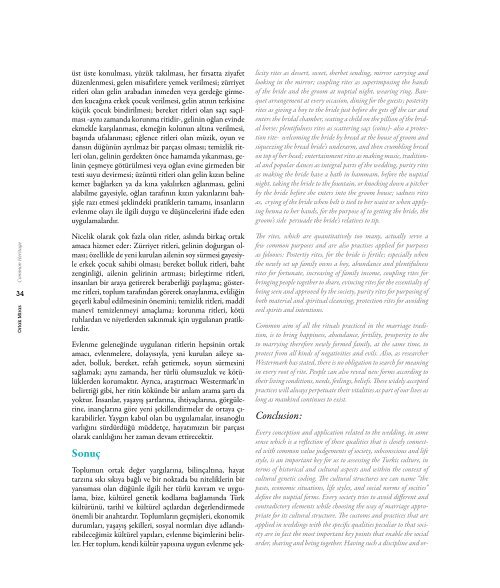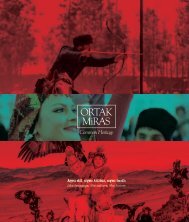You also want an ePaper? Increase the reach of your titles
YUMPU automatically turns print PDFs into web optimized ePapers that Google loves.
Common Heritage<br />
34<br />
Ortak Miras<br />
üst üste konulması, yüzük takılması, her fırsatta ziyafet<br />
düzenlenmesi, gelen misafirlere yemek verilmesi; zürriyet<br />
ritleri olan gelin arabadan inmeden veya gerdeğe girmeden<br />
kucağına erkek çocuk verilmesi, gelin atının terkisine<br />
küçük çocuk bindirilmesi; bereket ritleri olan saçı saçılması<br />
-aynı zamanda korunma ritidir-, gelinin oğlan evinde<br />
ekmekle karşılanması, ekmeğin kolunun altına verilmesi,<br />
başında ufalanması; eğlence ritleri olan müzik, oyun ve<br />
dansın düğünün ayrılmaz bir parçası olması; temizlik ritleri<br />
olan, gelinin gerdekten önce hamamda yıkanması, gelinin<br />
çeşmeye götürülmesi veya oğlan evine girmeden bir<br />
testi suyu devirmesi; üzüntü ritleri olan gelin kızın beline<br />
kemer bağlarken ya da kına yakılırken ağlanması, gelini<br />
alabilme gayesiyle, oğlan tarafının kızın yakınlarını bahşişle<br />
razı etmesi şeklindeki pratiklerin tamamı, insanların<br />
evlenme olayı ile ilgili duygu ve düşüncelerini ifade eden<br />
uygulamalardır.<br />
Nicelik olarak çok fazla olan ritler, aslında birkaç <strong>ortak</strong><br />
amaca hizmet eder: Zürriyet ritleri, gelinin doğurgan olması;<br />
özellikle de yeni kurulan ailenin soy sürmesi gayesiyle<br />
erkek çocuk sahibi olması; bereket bolluk ritleri, baht<br />
zenginliği, ailenin gelirinin artması; birleştirme ritleri,<br />
insanları bir araya getirerek beraberliği paylaşma; gösterme<br />
ritleri, toplum tarafından görerek onaylanma, evliliğin<br />
geçerli kabul edilmesinin önemini; temizlik ritleri, maddî<br />
manevî temizlenmeyi amaçlama; korunma ritleri, kötü<br />
ruhlardan ve niyetlerden sakınmak için uygulanan pratiklerdir.<br />
Evlenme geleneğinde uygulanan ritlerin hepsinin <strong>ortak</strong><br />
amacı, evlenmelere, dolayısıyla, yeni kurulan aileye saadet,<br />
bolluk, bereket, refah getirmek, soyun sürmesini<br />
sağlamak; aynı zamanda, her türlü olumsuzluk ve kötülüklerden<br />
korumaktır. Ayrıca, araştırmacı Westermark’ın<br />
belirttiği gibi, her ritin kökünde bir anlam arama şartı da<br />
yoktur. İnsanlar, yaşayış şartlarına, ihtiyaçlarına, görgülerine,<br />
inançlarına göre yeni şekillendirmeler de ortaya çıkarabilirler.<br />
Yaygın kabul olan bu uygulamalar, insanoğlu<br />
varlığını sürdürdüğü müddetçe, hayatımızın bir parçası<br />
olarak canlılığını her zaman devam ettirecektir.<br />
Sonuç<br />
Toplumun <strong>ortak</strong> değer yargılarına, bilinçaltına, hayat<br />
tarzına sıkı sıkıya bağlı ve bir noktada bu niteliklerin bir<br />
yansıması olan düğünle ilgili her türlü kavram ve uygulama,<br />
bize, kültürel genetik kodlama bağlamında Türk<br />
kültürünü, tarihî ve kültürel açılardan değerlendirmede<br />
önemli bir anahtardır. Toplumların geçmişleri, ekonomik<br />
durumları, yaşayış şekilleri, sosyal normları diye adlandırabileceğimiz<br />
kültürel yapıları, evlenme biçimlerini belirler.<br />
Her toplum, kendi kültür yapısına uygun evlenme şeklicity<br />
rites as dessert, sweet, sherbet sending, mirror carrying and<br />
looking in the mirror; coupling rites as superimposing the hands<br />
of the bride and the groom at nuptial night, wearing ring, Banquet<br />
arrangement at every occasion, dining for the guests; posterity<br />
rites as giving a boy to the bride just before she gets off the car and<br />
enters the bridal chamber, seating a child on the pillion of the bridal<br />
horse; plentifulness rites as scattering saçı (coins)- also a protection<br />
rite- welcoming the bride by bread at the house of groom and<br />
siqueezing the bread bride’s underarm, and then crumbling bread<br />
on top of her head; entertainment rites as making music, traditional<br />
and popular dances as integral parts of the wedding, purity rites<br />
as making the bride have a bath in hammam, before the nuptial<br />
night, taking the bride to the fountain, or knocking down a pitcher<br />
by the bride before she enters into the groom house; sadness rites<br />
as, crying of the bride when belt is tied to her waist or when applying<br />
henna to her hands, for the purpose of to getting the bride, the<br />
groom’s side persuade the bride’s relatives to tip.<br />
The rites, which are quantitatively too many, actually serve a<br />
few common purposes and are also practises applied for purposes<br />
as foloows: Postertiy rites, for the bride is fertile; especially when<br />
the newly set up family owns a boy, abundance and plentifulness<br />
rites for fortunate, increasing of family income, coupling rites for<br />
bringing people together to share, evincing rites for the essentialty of<br />
being seen and approved by the society, purity rites for purposing of<br />
both material and spiritual cleansing, protection rites for avoiding<br />
evil spirits and intentions.<br />
Common aim of all the rituals practiced in the marriage tradition,<br />
is to bring happiness, abundance, fertility, prosperity to the<br />
to marrying therefore newly formed family, at the same time, to<br />
protect from all kinds of negativities and evils. Also, as researcher<br />
Westermark has stated, there is no obligation to search for meaning<br />
in every root of rite. People can also reveal new forms according to<br />
their living conditions, needs, feelings, beliefs. These widely accepted<br />
practices will always perpetuate their vitalities as part of our lives as<br />
long as mankind continues to exist.<br />
Conclusion:<br />
Every conception and application related to the wedding, in some<br />
sense which is a reflection of these qualities that is closely connected<br />
with common value judgements of society, subconscious and life<br />
style, is an important key for us to assessing the Turkic culture, in<br />
terms of historical and cultural aspects and within the context of<br />
cultural genetic coding. The cultural structures we can name “the<br />
pasts, economic situations, life styles, and social norms of socities”<br />
define the nuptial forms. Every society tries to avoid different and<br />
contradictory elements while choosing the way of marriage appropriate<br />
for its cultural structure. The customs and practices that are<br />
applied in weddings with the specific qualities peculiar to that society<br />
are in fact the most important key points that enable the social<br />
order, sharing and being together. Having such a discipline and or-
















